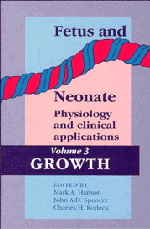11 - Clinical assessment of placental function
from Part III - Clinical applications
Published online by Cambridge University Press: 04 August 2010
Summary
Introduction
Growth – conceptual concerns
In any discussion regarding the assessment of fetal size and fetal growth, it is absolutely essential to differentiate between ‘small for gestational age’ (SGA) and ‘intrauterine growth retardation’ (IUGR). This distinction between size and growth is critical. A single estimate of fetal size in the third trimester is of little clinical usefulness as a measure of the adequacy of growth. For instance, if such an estimate of weight indicates that the fetus is below, say, the tenth centile for gestational age, the suggestion that this may indicate IUGR is quite unjustified because 10% of all babies born will lie below the tenth centile of a normal Gaussian distribution. Furthermore, other babies with weights well above the tenth centile may be suffering IUGR as a result of failing to achieve their full growth potential. It therefore follows that IUGR cannot be diagnosed from birthweight and gestational age alone (Thomson & Billewicz, 1976). This term should be restricted to those fetuses in whom there is clear evidence that the rate of intrauterine growth has faltered. It follows that many growth-retarded fetuses would have a weight above the tenth centile of the population range. A considerable but unknown proportion of these infants will have no adverse sequelae.
Growth cannot be estimated from less than two measurements of size. The clinician ideally would wish to know whether the fetal growth rate has deviated from its normal progression, therefore serial measurements are desirable.
- Type
- Chapter
- Information
- Fetus and Neonate: Physiology and Clinical Applications , pp. 277 - 296Publisher: Cambridge University PressPrint publication year: 1995



